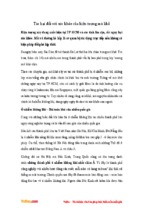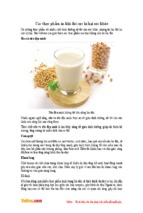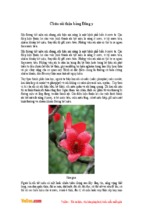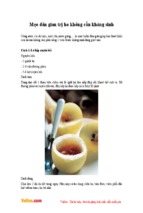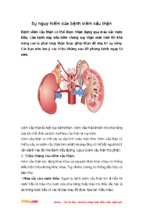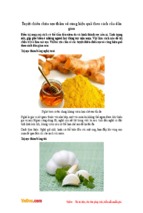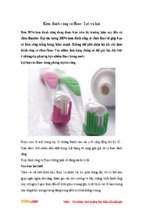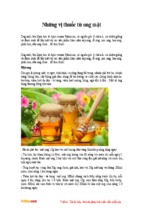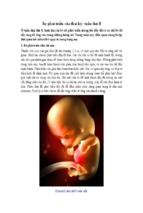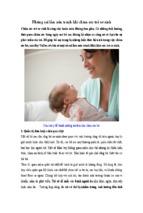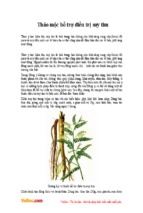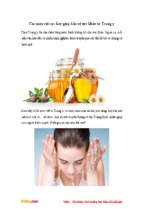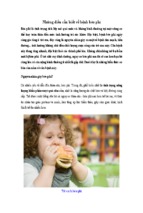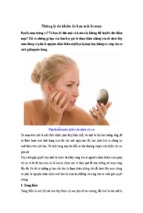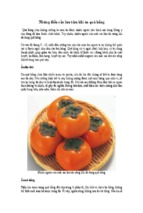WHO
monographs
on selected
medicinal plants
VOLUME 2
World Health Organization
Geneva
2002
WHO Library Cataloguing-in-Publication Data
WHO monographs on selected medicinal plants.—Vol. 2.
1.Plants, Medicinal 2.Herbs
ISBN 92 4 154537 2
(NLM Classification: QV 766)
The World Health Organization welcomes requests for permission to reproduce or translate its
publications, in part or in full. Applications and enquiries should be addressed to the Office of
Publications, World Health Organization, Geneva, Switzerland, which will be glad to provide the
latest information on any changes made to the text, plans for new editions, and reprints and
translations already available.
© World Health Organization 2002
Publications of the World Health Organization enjoy copyright protection in accordance with the
provisions of Protocol 2 of the Universal Copyright Convention. All rights reserved.
The designations employed and the presentation of the material in this publication do not imply
the expression of any opinion whatsoever on the part of the Secretariat of the World Health
Organization concerning the legal status of any country, territory, city or area or of its authorities,
or concerning the delimitation of its frontiers or boundaries.
The mention of specific companies or of certain manufacturers’ products does not imply that they
are endorsed or recommended by the World Health Organization in preference to others of a
similar nature that are not mentioned. Errors and omissions excepted, the names of proprietary
products are distinguished by initial capital letters.
Designed by WHO Graphics
Typeset in Hong Kong
Printed in Malta
2001/13613-SNPBest-set/Interprint-7700
Contents
Acknowledgements
Introduction
General technical notices
v
1
3
Monographs (in alphabetical order of plant name)
Radix Althaeae
Herba Andrographidis
Radix Angelicae Sinensis
Flos Calendulae
Flos Caryophylli
Rhizoma Cimicifugae Racemosae
Folium cum Flore Crataegi
Radix Eleutherococci
Aetheroleum Eucalypti
Folium Eucalypti
Cortex Frangulae
Folium et Cortex Hamamelidis
Semen Hippocastani
Herba Hyperici
Aetheroleum Melaleucae Alternifoliae
Folium Melissae
Aetheroleum Menthae Piperitae
Folium Menthae Piperitae
Folium Ocimi Sancti
Oleum Oenotherae Biennis
Rhizoma Piperis Methystici
Cortex Pruni Africanae
Cortex Rhamni Purshianae
Flos Sambuci
Radix Senegae
Fructus Serenoae Repentis
5
12
25
35
45
55
66
83
97
106
114
124
137
149
172
180
188
199
206
217
231
246
259
269
276
285
iii
Contents
Fructus Silybi Mariae
Herba Tanaceti Parthenii
Radix Urticae
Folium Uvae Ursi
300
317
329
342
Annex 1
Participants in the Second WHO Consultation on Selected
Medicinal Plants
352
Annex 2
Cumulative index (in alphabetical order of plant name)
354
Annex 3
Cumulative index (in alphabetical order of plant material of interest)
356
iv
Acknowledgements
Special acknowledgement is due to Professors Norman R. Farnsworth, Harry
H.S. Fong and Gail B. Mahady of the WHO Collaborating Centre for Traditional Medicine, College of Pharmacy, University of Illinois at Chicago,
Chicago, IL, USA, for drafting and revising the monographs. Similarly, special
acknowledgement is also due to Dr Raymond Boudet-Dalbin of the Laboratoire de Chimie thérapeutique at the University René Descartes, Paris, France,
for drawing the chemical structures for both volumes 1 and 2. The photograph
for the front cover was kindly provided by Professor Kurt Hostettmann of
the Institut de Pharmacognosie et Phytochimie at the University of Lausanne,
Lausanne, Switzerland.
WHO also acknowledges with thanks the valuable work of the approximately 120 experts in more than 50 countries who provided comments and
advice on the draft texts; those who submitted comments through the World
Self-Medication Industry (a nongovernmental organization in official relations
with WHO); and those who participated in the Second WHO Consultation on
Selected Medicinal Plants held in Ravello-Salerno, Italy, in March 1999 to
review the monographs (see Annex 1).
Finally, WHO would like to thank the Ministry of Health of Italy; the
Government of the Province of Salerno, Italy; the WHO Collaborating Centre
for Traditional Medicine at the Centre of Research in Bioclimatology, Biotechnologies and Natural Medicines of the State University of Milan, Italy; and
the State University of Salerno, Italy, who hosted and supported the Second
WHO Consultation.
v
This Page Intentionally Left Blank
Introduction
Role of the WHO monographs on selected medicinal plants
The first volume of the WHO monographs on selected medicinal plants, containing
28 monographs, was published in 1999. It is gratifying that the importance of
the monographs is already being recognized. For example, the European Commission has recommended volume 1 to its Member States as an authoritative
reference on the quality, safety and efficacy of medicinal plants. The Canadian
Government has also made a similar recommendation. Furthermore, as hoped,
some of WHO’s Member States, such as Benin, Mexico, South Africa and Viet
Nam, have developed their own monographs based on the format of the WHO
monographs.
The monographs are not only a valuable scientific reference for health
authorities, scientists and pharmacists, but will also be of interest to the general
public. There can be little doubt that the WHO monographs will continue to
play an important role in promoting the proper use of medicinal plants throughout the world.
Preparation of monographs for volume 2
At the eighth International Conference on Drug Regulatory Authorities
(ICDRA) held in Manama, Bahrain, in 1996, WHO reported the completion of
volume 1 of the WHO monographs. Member States requested WHO to continue to develop additional monographs. As a consequence, preparation of the
second volume began in 1997.
During the preparation, the number of experts involved, in addition to
members of WHO’s Expert Advisory Panel on Traditional Medicine, significantly increased compared to that for volume 1. Similarly, the number
of national drug regulatory authorities who participated in the preparation
also greatly increased. This global network of active collaborators facilitated
wider access to the scientific references and information, thus increasing both
the quality and quantity of the monographs. These combined efforts greatly
improved the efficiency of the preparation. As for volume 1, the monographs
were drafted by the WHO Collaborating Centre for Traditional Medicine at the
University of Illinois at Chicago, United States of America.
The Second WHO Consultation on Selected Medicinal Plants was held in
Ravello-Salerno, Italy, in March 1999 to review and finalize the draft monographs. Twenty experts and drug regulatory authorities from WHO Member
1
Introduction
States participated (see Annex 1). Following extensive discussion, 30 of 31 draft
monographs were approved for volume 2. At the subsequent ninth ICDRA in
Berlin, Germany in April 1999, the 30 draft monographs were presented, and
Member States requested WHO to publish them as soon as possible.
Purpose and content of the monographs
The purpose of the monographs was clearly explained in the introduction to
volume 1, and it is unnecessary to repeat it here. However, it is important to
emphasize that the word “monograph”, as appears in the title, is used as a technical term only. These monographs are not intended to be official pharmacopoeial monographs.
It should also be stressed that this publication is not intended to replace official compendia such as pharmacopoeias, formularies or legislative documents.
Furthermore, the descriptions included in the section on medicinal uses should
not be taken as implying WHO’s official endorsement or approval. They merely
represent the systematic collection of scientific information available at the time
of preparation, for the purpose of facilitating information exchange.
A description of selected sections of the monographs is given in the General
technical notices. For easy reference, two cumulative indexes are also provided
as annexes. Annex 2 lists the monographs in alphabetical order of the plant
name, while Annex 3 is according to the plant material of interest.
Dr Xiaorui Zhang
Acting Coordinator
Traditional Medicine
Department of Essential Drugs and Medicines Policy
World Health Organization
2
General technical notices
These WHO monographs are not pharmacopoeial monographs. Their purpose is to provide scientific information on the safety, efficacy and quality
control/quality assurance of widely used medicinal plants, in order to facilitate
their appropriate use in WHO’s Member States; to provide models to assist
WHO’s Member States in developing their own monographs or formularies for
these and other herbal medicines; and to facilitate information exchange among
WHO’s Member States.
The format used for volume 2 essentially follows that of volume 1.
However, to keep relevant sections together, Geographical distribution now precedes Description; and Dosage forms appears before Posology.
The Definition describes the identity of the plant material of interest and the
Latin binomial name of the source plant, the binomial name being the most
important criterion in quality assurance of the crude drug. Latin pharmacopoeial synonyms and vernacular names, listed in the sections Synonyms and
Selected vernacular names, respectively, are those names used in commerce or by
local consumers. The monographs place outdated botanical nomenclature in
the synonyms category, based on the International rules of nomenclature.
The vernacular names listed are a selection of names from individual countries worldwide, in particular from areas where the medicinal plant is in
common use. The lists are not complete, but reflect the names found at the
time of preparation in official monographs, reference books and the Natural
Products Alert (NAPRALERT) database (a database of literature from around
the world on ethnomedical, biological and chemical information on medicinal
plants, fungi and marine organisms, located at the WHO Collaborating Centre
for Traditional Medicine at the University of Illinois at Chicago, USA).
A detailed botanical description (in Description) is intended for quality assurance at the stages of production and collection of the source plant, whereas the
detailed description of the specific plant part used (the crude drug)—in Plant
material of interest—is for quality assurance at the manufacturing and commercial stages. Geographical distribution is not normally found in official compendia,
but it is included here to provide additional quality assurance information.
General identity tests, Purity tests and Chemical assays are all normal compendial components included under those headings in these monographs. Where
purity tests do not specify accepted limits, those limits should be set in accordance with requirements of the respective national health authorities.
Each medicinal plant and crude drug contains active or major chemical constituents with a characteristic profile that can be used for chemical quality
3
General technical notices
control and quality assurance. These constituents are described in the section
Major chemical constituents.
Descriptions included in the section on Medicinal uses should not be taken
as implying WHO’s official endorsement or approval. They merely represent
the systematic collection of scientific information available at the time of preparation, for information exchange. Medicinal uses are categorized as uses supported by clinical data; uses described in pharmacopoeias and in traditional
systems of medicine; and uses described in folk medicine, not yet supported
by experimental or clinical data.
The first category includes medicinal indications that are well established
in some countries and have been validated by clinical studies documented in
the scientific literature. The clinical trials may have been controlled, randomized, double-blind studies, trials without controls, cohort studies, or welldocumented observations of therapeutic applications.
The second category includes medicinal uses that are well established in
many countries and are included in official pharmacopoeias or national monographs. Well-established uses having a plausible pharmacological basis and supported by older studies that clearly need to be repeated are also included. The
references cited provide additional information useful in evaluating specific
herbal preparations. The uses described should be reviewed by local experts
and health workers for their applicability in the local situation.
The third category refers to indications described in unofficial pharmacopoeias and other literature, and to traditional uses. The appropriateness of
these uses could not be assessed, owing to a lack of scientific data to support
the claims. The possible uses of these remedies must be carefully considered
in the light of therapeutic alternatives.
The Experimental pharmacology section includes only the results of investigations that prove or disprove the cited medicinal uses. Abbreviated details of the
best-performed studies have been included in this section. Other published
experimental data that are not associated with the medicinal uses have not been
included to avoid confusion.
The details included in the section on References have been checked against
the original sources wherever possible. However, in some cases, details are
missing as the original sources were not available. For non-English language references, the title is given in the original language, except in cases where an
English summary is available.
4
Radix Althaeae
Definition
Radix Althaeae consists of the dried roots of Althaea officinalis L. (Malvaceae)
(1–4).
Synonym
Malva officinalis L. (5).
Selected vernacular names
Altea, altee, althea, bardul khatmi, benefischi, bismalva-hibiscus, blanca
malva, bon visclo, bourdon de St Jacques, Eibisch, Eibischwurzel, erva molle,
guimauve, Heilwurz, hobbiza, Ibischwurz, khairi, khatmi, korzén prawóslazu, marshmallow, marshmallow root, malvaccioniu, malvavisco, marmolone, molotta, Moorish mallow, orvosiziliz gyökér, racine d’althée, racine de
guimauve, Sammetpappel, sauvage, Schleimwurzel, suzmool, sweet weed,
white mallow, wymote (3, 6–8).
Geographical distribution
Indigenous to western Asia and Europe, and is naturalized in the United States
of America (9, 10). Roots are obtained from commercially cultivated plants that
are at least 2 years old and harvested in the autumn (6, 10).
Description
A perennial herb with erect, woody stems, 60–120 cm high. Leaves alternate,
ovate to slightly cordate, serrate, velvety, large, occasionally 3-lobed. Flowers
pale pink, axillary, the calyx of each surrounded by a 6–9 cleft involucre. Fruit
a set of cocci united into a ring (11).
Plant material of interest: dried roots
General appearance
Cylindrical or tapering, slightly twisted roots, up to 2 cm thick, with deep
longitudinal furrows. Outer surface greyish-brown, bearing numerous rootlet
scars. Fracture externally fibrous, internally rugged and granular; section shows
5
WHO monographs on selected medicinal plants
a thick, whitish bark with brownish periderm, separated by a well-marked,
brownish cambium from the white xylem; stratified structure of the bark and
radiate structure of xylem become more distinct when moist. Peeled root
has greyish-white finely fibrous outer surface; cork and external cortical
parenchyma absent (2).
Organoleptic properties
Odour: faint, aromatic; taste: mucilaginous (1).
Microscopic characteristics
Phloem with numerous long, thin-walled, non-lignified fibres arranged in tangential groups alternating with groups of sieve tissue, with a ground tissue of
thin-walled parenchyma; xylem containing reticulate or scalariform thickening
and bordered pits accompanied by lignified tracheids, a small amount of lignified parenchyma and occasional small groups of fibres with only the middle
lamella lignified; xylem and phloem transversed by numerous non-lignified
medullary rays, mostly uniseriate; majority of parenchyma cells of the phloem
and medullary rays contain abundant small starch grains which are mostly
simple, spherical to ovoid, occasionally 2–3 compound, with a well-marked
circular or slit-shaped hilum; some of these parenchyma cells contain cluster
crystals of calcium oxalate 20–40 mm in diameter, while others exist as
idioblasts containing mucilage (1).
Powdered plant material
Brownish-grey (unpeeled root) or whitish (peeled root). Fragments of colourless, mainly unlignified, thick-walled fibres with pointed or split ends; fragments of reticulate or scalariform thickening and bordered pits; cluster crystals
of calcium oxalate about 20–35 mm, mostly 25–30 mm, in diameter; parenchyma
cells containing mucilage; fragments of cork with thin-walled, tabular cells in
the powdered material from the unpeeled root. Numerous starch grains, 3–
25 mm in diameter, with occasionally a longitudinal hilum; starch grains mostly
simple, a few being 2–4 compound (2).
General identity tests
Macroscopic and microscopic examinations (1, 2).
Purity tests
Microbiology
Tests for specific microorganisms and microbial contamination limits are as
described in the WHO guidelines on quality control methods for medicinal
plants (12).
6
Radix Althaeae
Foreign organic matter
Not more than 2% of brown, deteriorated drug and not more than 2% of cork
in the peeled root (2).
Total ash
Not more than 6% in the peeled root and not more than 8% in the unpeeled
root (2).
Acid-insoluble ash
Not more than 3% in the peeled root (1).
Water-soluble extractive
Not less than 22% (1).
Loss on drying
Not more than 12% (2).
Swelling index
Not less than 10 (2).
Pesticide residues
The recommended maximum limit of aldrin and dieldrin is not more than
0.05 mg/kg (2). For other pesticides, see the European pharmacopoeia (2), and the
WHO guidelines on quality control methods for medicinal plants (12) and
pesticide residues (13).
Heavy metals
For maximum limits and analysis of heavy metals, consult the WHO guidelines
on quality control methods for medicinal plants (12).
Radioactive residues
Where applicable, consult the WHO guidelines on quality control methods for
medicinal plants (12) for the analysis of radioactive isotopes.
Other purity tests
Chemical, sulfated ash and alcohol-soluble extractive tests to be established in
accordance with national requirements.
Chemical assays
Not less than 10% total mucilage in the peeled root as determined by gravimetric analysis (14).
7
WHO monographs on selected medicinal plants
Major chemical constituents
The mucilage content ranges from 10 to 20% and consists of a mixture of acidic
galacturonorhamnans, neutral glucans and neutral arabinogalactans (6, 8, 9,
15–17).
Medicinal uses
Uses supported by clinical data
None.
Uses described in pharmacopoeias and in traditional systems
of medicine
As a demulcent for symptomatic treatment of dry irritable coughs and irritations of oral and pharyngeal mucosa and as an emollient for wounds and dry
skin (8, 18–23). Also used in cough mixtures to mask the bitter or pungent taste
of other drugs (16).
Uses described in folk medicine, not supported by experimental
or clinical data
Treatment of asthma, cystitis, dysentery and irritations of the gastric mucosa
(7).
Pharmacology
Experimental pharmacology
The demulcent effects of Radix Althaeae are due to its high content of polysaccharide hydrocolloids, which form a protective coating on the oral and
pharyngeal mucosa, soothing local irritation and inflammation (24).
Anti-inflammatory activity
A polysaccharide fraction (500 mg/ml) isolated from a root extract had anticomplement activity in human serum in vitro (25). Aqueous extracts of
the roots stimulated phagocytosis, and the release of oxygen radicals and
leukotrienes from human neutrophils in vitro (26). The aqueous extract also
induced the release of cytokines, interleukin-6 and tumour necrosis factor
from human monocytes in vitro, thereby exhibiting anti-inflammatory and
immunostimulant activity (26). Intraperitoneal administration of isolated
mucilage polysaccharides to mice (10 mg/kg body weight) induced a 2.2-fold
increase in the phagocytic activity of macrophages as measured by the colloidal
carbon clearance test (27). However, intragastric administration of an 80%
ethanol extract of the roots to rats (100 mg/kg body weight) did not inhibit
carrageenan-induced footpad oedema (28).
8
Radix Althaeae
Weak inhibition (17%) of mucociliary transport in isolated, ciliated epithelium of the frog oesophagus was demonstrated after treatment of the isolated
tissues with 200 ml of an aqueous root macerate (6.4 g/140 ml) (29).
Antitussive activity
Intragastric administration of a polysaccharide fraction, isolated from an
aqueous root extract, to cats (50 mg/kg body weight) suppressed the intensity
and the frequency of coughs induced by mechanical irritation of laryngopharyngeal and tracheobronchial mucosa (30). The antitussive activity of this
polysaccharide fraction (50 mg/kg body weight) was as effective as Syrupus
Althaeae (1.0 g/kg body weight), and more effective than prenoxdiazine
(30 mg/kg body weight) (30).
Clinical pharmacology
None.
Contraindications
No information available.
Warnings
No information available.
Precautions
Drug interactions
Simultaneous administration of Radix Althaeae may delay the absorption of
other drugs (8).
Other precautions
No information available on general precautions or precautions concerning drug
and laboratory test interactions; carcinogenesis, mutagenesis, impairment of
fertility; teratogenic and non-teratogenic effects in pregnancy; nursing mothers;
or paediatric use. Therefore, Radix Althaeae should not be administered during
pregnancy or lactation or to children without medical supervision.
Adverse reactions
No information available.
9
WHO monographs on selected medicinal plants
Dosage forms
Peeled or unpeeled, broken, chopped or powdered crude drug (1, 2) and galenical preparations thereof. Store in a well-closed container, protected from light
(2).
Posology
(Unless otherwise indicated)
For dry cough, oral or pharyngeal irritation: 0.5–3.0 g of crude drug as an
aqueous, cold macerate (14, 19, 20, 31) or 2–8 ml of syrup (20, 22, 32), which
may be repeated up to a daily dose of 15 g of crude drug. For gastric irritation:
3–5 g of crude drug as an aqueous, cold macerate up to three times daily (19,
20, 31).
References
1. British herbal pharmacopoeia. London, British Herbal Medicine Association, 1996.
2. European pharmacopoeia, 3rd ed. Strasbourg, Council of Europe, 1996.
3. Farmakopea Polska V, Suplement I. Warsaw, Polskie Towarzystwo Farmaceutyczne,
1995.
4. Pharmacopoeia Hungarica, 7th ed. Budapest, Hungarian Pharmacopoeia Commission,
Medicina Konyvkiado, 1986.
5. Hooker JD, Jackson BD. Index Kewensis. Vol. 1. Oxford, Clarendon Press, 1895.
6. Bisset NG. Herbal drugs and phytopharmaceuticals. Boca Raton, FL, CRC Press, 1994.
7. Farnsworth NR, ed. NAPRALERT database. Chicago, University of Illinois at
Chicago, IL, February 9, 1998 production (an online database available directly
through the University of Illinois at Chicago or through the Scientific and Technical Network [STN] of Chemical Abstracts Services).
8. Hänsel R et al., eds. Hagers Handbuch der pharmazeutischen Praxis. Bd. 6: Drogen P–Z,
5th ed. Berlin, Springer-Verlag, 1994.
9. Leung AY, Foster S. Encyclopedia of common natural ingredients used in food, drugs, and
cosmetics, 2nd ed. New York, NY, John Wiley & Sons, 1996.
10. Leung AY. Encyclopedia of common natural ingredients. New York, NY, John Wiley &
Sons, 1980.
11. Youngken HW. Textbook of pharmacognosy, 6th ed. Philadelphia, PA, Blakiston, 1950.
12. Quality control methods for medicinal plant materials. Geneva, World Health Organization, 1998.
13. Guidelines for predicting dietary intake of pesticide residues, 2nd rev. ed. Geneva, World
Health Organization, 1997 (document WHO/FSF/FOS/97.7).
14. Pharmacopée française. Paris, Adrapharm, 1996.
15. Blaschek W, Franz G. A convenient method for the quantitative determination of
mucilage polysaccharides in Althaeae radix. Planta Medica, 1986, 52:537.
16. Samuelsson G, ed. Drugs of natural origin, a textbook of pharmacognosy. Stockholm,
Swedish Pharmaceutical Press, 1992.
17. Tomoda M et al. The structural features of Althaea-mucilage representative mucous
polysaccharide from the roots of Althaea officinalis. Chemical and Pharmaceutical
Bulletin, 1980, 28:824–830.
18. Bone K. Marshmallow soothes cough. British Journal of Phytotherapy, 1993/1994, 3:93.
19. Marshmallow root. In: Bradley PR, ed. British herbal compendium. Vol. 1. Bournemouth, British Herbal Medicine Association, 1992:151–153.
10
Radix Althaeae
20. ESCOP monographs on the medicinal uses of plant drugs. Fascicule 1. Elberg, European
Scientific Cooperative on Phytotherapy, 1996.
21. Blumenthal M et al., eds. The complete German Commission E monographs. Austin, TX,
American Botanical Council, 1998.
22. Reynolds JEF, ed. Martindale, the extra pharmacopoeia, 29th ed. London, Pharmaceutical Press, 1989.
23. Weiss RF. Lehrbuch der Phytotherapie, 7th ed. Stuttgart, Hippokrates Verlag, 1991.
24. Franz G. Polysaccharides in pharmacy: current applications and future concepts.
Planta Medica, 1989, 55:493–497.
25. Yamada H et al. Relationship between chemical structure and anti-complementary
activity of plant polysaccharides. Carbohydrate Research, 1985, 144:101–111.
26. Scheffer J et al. Radix althaeae und Flores chamomillae Extrakte auf Entzündungsreaktionen humaner neutrophiler Granulozyten, Monozyten und Rattenmastzellen. In: Abstracts of the Third Phytotherapy Congress. Lübeck-Travemünde, 1991:
Abstract P9.
27. Wagner H, Proksch A. Immunostimulatory drugs of fungi and higher plants. In:
Wagner H, Hikino H, Farnsworth NR, eds. Economic and medicinal plant research. Vol.
1. Orlando, FL, Academic Press, 1985:111–153.
28. Mascolo N et al. Biological screening of Italian medicinal plants for antiinflammatory activity. Phytotherapy Research, 1987, 1:28–31.
29. Müller-Limmroth W, Fröhlich HH. Wirkungsnachweis einiger phytotherapeutischer
Expektorantien auf den mukoziliaren Transport. Fortschritte der Medizin, 1980, 98:
95–101.
30. Nosal’ova G et al. Antitussive efficacy of the complex extract and the polysaccharide of marshmallow (Althaea officinalis L. var. Robusta). Pharmazie, 1992, 47:224–226.
31. Wichtl M. Eibischwurzel. In: Wichtl M, ed. Teedrogen, 2nd ed. Stuttgart, Wissenschaftliche Verlagsgesellschaft, 1989:146–147.
32. British pharmaceutical codex. London, Pharmaceutical Press, 1934.
11
Herba Andrographidis
Definition
Herba Andrographidis consists of the dried aerial parts of Andrographis paniculata (Burm. f.) Nees (Acanthaceae) (1–3).
Synonyms
Justicia latebrosa Russ., J. paniculata Burm. f., J. stricta Lam. ex Steud. (3, 4).
Selected vernacular names
Akar cerita bidara, alui, Andrographidis Kraut, bidara, bhoonimba, bhuinimo,
bhulimb, bhuninba, charayeta, charayetha, charita, cheranta, cherota, chiraita,
chiretta, chuan-hsin-lien, chuan-xın-lián, công công, faathalaaichon, fathalaai,
¯ ¯
fathalaichon, fathalaijone, halviva, herba sambiloto, hinbinkohomba, I-chienhsi, kalafath, kalmegh, kan-jang, kariyat, khee-pang-hee, king of bitters,
kiriathu, kirta, kiryata, kiryato, lanhelian, mahatikta, mahatita, naelavemu, naynahudandi, nelavemu, quasab-uz-zarirah, rice bitters, sambilata, sambiloto,
senshinren, sinta, xuyên tâm liên, yaa kannguu yijianxi (1, 2, 5–11).
Geographical distribution
Widely found and cultivated in tropical and subtropical Asia, south-east Asia
and India (6, 8, 10).
Description
A herbaceous annual, erect, up to 1 m high; stem acutely quadrangular, much
branched. Leaves simple, opposite, lanceolate, glabrous, 2–12 cm long, 1–3 cm
wide; apex acute; margin entire, slightly undulate, upper leaves often bractiform; petiole short. Inflorescence patent, terminal and axillary in panicle, 10–
30 mm long; bract small; pedicel short. Calyx 5-particle, small, linear. Corolla
tube narrow, about 6 mm long; limb longer than the tube, bilabiate; upper lip
oblong, white with a yellowish top; lower lip broadly cuneate, 3-lobed, white
with violet markings. Stamens 2, inserted in the throat and far exserted; anther
basally bearded. Superior ovary, 2-celled; style far exserted. Capsule erect,
linear-oblong, 1–2 cm long and 2–5 mm wide, compressed, longitudinally furrowed on broad faces, acute at both ends, thinly glandular-hairy. Seeds small,
subquadrate (1–3, 5, 10).
12
Herba Andrographidis
Plant material of interest: dried aerial parts
General appearance
Mixture of broken, crisp, mainly dark green lanceolate leaves and quadrangular stems; capsule fruit and small flowers occasionally found (1, 3). Stem texture
fragile, easily broken; leaves simple, petiole short or nearly sessile, lanceolate
or ovate-lanceolate, with acuminate apex and cuneate-decurrent base, lamina
crumpled and easily broken (2).
Organoleptic properties
Odour: slight, characteristic; taste: intensely bitter (1–3, 9).
Microscopic characteristics
Leaf upper epidermis: stomata absent, glandular trichomes present, unicellular
and multicellular trichomes rare, cystoliths fairly large; lithocysts large (27–
30 mm thick, 96–210 mm long and up to 49 mm wide); columnar palisade cells;
collenchyma in midrib beneath epidermis; parenchyma cells spongy; vascular
bundles of lignified xylem in the upper part and lignified phloem in the lower
part; spiral, scalariform and reticulate vessels. Leaf lower epidermis: a layer of
wavy-walled cells; stomata diacytic; trichomes up to 36 mm in diameter and 180
mm long, and cystoliths present. Stem: epidermis has glandular and non-glandular trichomes. Collenchyma dense at the corners of stems; parenchyma contains chloroplastids. Endodermis composed of a layer of thick-walled cells.
Wood with spiral, scalariform and pitted xylem vessels; pith composed of large
parenchyma cells. Small acicular crystals of calcium oxalate occur in the pith
and cortical cells of stem and leaf (1–3, 8).
Powdered plant material
Leaf fragments in surface view show upper epidermis with underlying palisade
and cystoliths, lower epidermis with underlying palisade cells with stomata,
cystoliths and glandular trichomes. Leaf fragments in sectional view show
upper epidermis with palisade cells, spongy parenchyma cells, vascular bundles;
and lower epidermis with bundles of xylem associated with fibres; fragments
of spiral, scalariform, reticulate and pitted vessels; fragments of epidermal cells
from midrib; fragments of parenchyma cells in transverse and longitudinal
sections. Bundles of fibres. Fragments of epidermal cells from stem with
stomata, cystoliths and glandular trichomes. Scattered cystoliths; scattered unicellular and multicellular trichomes, mostly from epidermal cells in fruit walls;
scattered glandular trichomes from bundles of fibres in fruit wall; scattered
pollen grains (1).
General identity tests
Macroscopic and microscopic examinations, chemical tests, and thin-layer
chromatography for the presence of diterpene lactones (1–3).
13
- Xem thêm -

